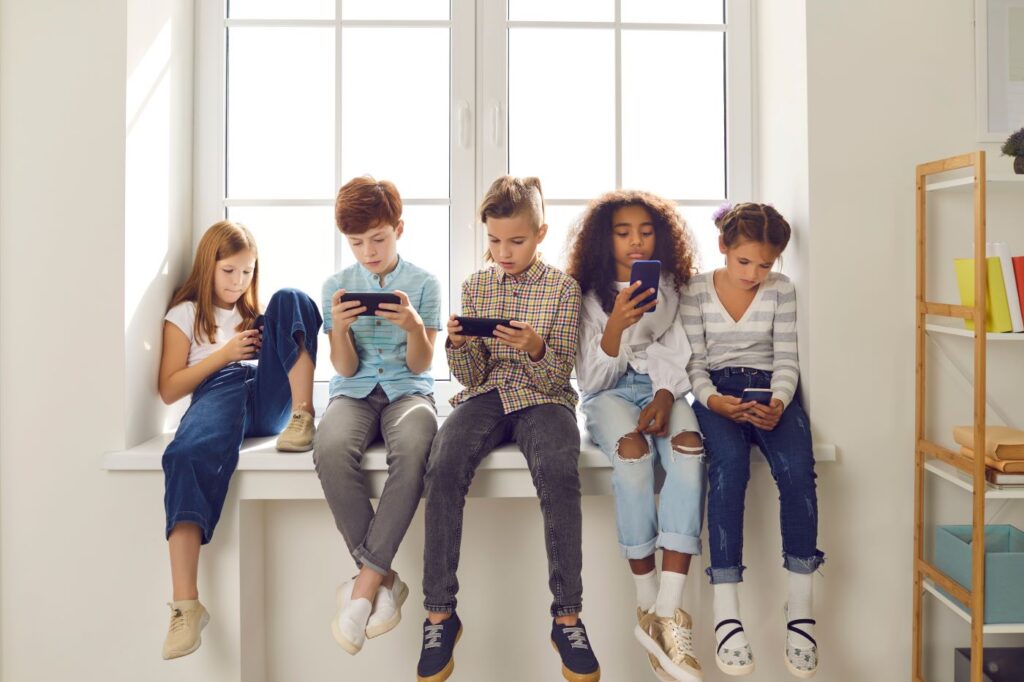“Mental health is a complex issue and the existing body of scientific work has not shown a causal link between using social media and young people having worse mental health outcomes.” This is the statement that Mark Zuckerberg recently gave under oath to the U.S. Senate Judiciary Committee. Zuckerberg’s statement is just the most recent example of how Big Tech CEOs have publicly denied for years that their products are harmful to children.
But the tide is finally turning.
In his new book, The Anxious Generation: How the Great Rewiring of Childhood Is Causing an Epidemic of Mental Illness, Jonathan Haidt has done the difficult work of proving what Big Tech has been denying: that their products, smartphones and social media, are killing our children. Haidt proves both that there is a problem––there is, in fact, a teen mental health crisis—and that the cause of the crisis is the phone-based childhood ushered in by smartphones and their social media apps. The question for us now, Haidt suggests, is, where we go from here. Haidt is no pessimist. Though the train has left the station, he argues, it is not too late to turn it around.
The Kids Are Not All Right
Start your day with Public Discourse
Sign up and get our daily essays sent straight to your inbox.It’s a shame that we live in such pervasive denial that Haidt had to go to such great lengths to prove what ought to be self-evident: Teens are constantly hunched over their phones. It is obvious that these devices and apps are not good for kids. Many parents are frustrated by these technologies and how they have taken over childhood. Every teacher laments how their students have changed, in both their learning abilities and social skills, as a result of these phones. It’s no wonder, then, that Haidt’s book has been so enthusiastically received, on both sides of the political aisle and by people across all walks of life.
Haidt is certainly not without his critics. Other academics have tried to point, unconvincingly, to other factors, like school shootings, the global financial crisis in 2008, or climate change, to explain the teen mental health crisis. (See Candice Odgers’s critical review in Nature and Jean Twenge’s response to it, for example).
The criticism of Haidt’s work, which has been personal at times, is not irrelevant. He has touched a nerve that cuts across our everyday lives and lucrative business interests. There are powerful incentives against the kind of work Haidt has done in this book, and so, at the cost of immense scrutiny, he has done us a favor by giving us the clarity that smartphones and social media are bad for our kids.
Haidt opens the first chapter of the book by laying out the evidence that the rates of teen anxiety, depression, self-harm, and loneliness exploded right after the advent of the smartphone and social media. Haidt calls the period from 2010 to 2015 the “Great Rewiring,” the time when smartphones and social media became widely adopted among teens and when we saw massive spikes in teen mental health problems. Haidt provides compelling evidence for his theory that the Great Rewiring is the main cause of the teen mental health crisis, after debunking other possible explanations because of the timing of the spikes and the international nature of the crisis across the Anglosphere.
Haidt identifies four foundational harms of the phone-based childhood: social deprivation, sleep deprivation, attention fragmentation, and addiction. He notes that while girls are more susceptible to harm from social media and boys suffer more from unrelenting exposure to pornography and video games, both stories end up in the same place: Boys and girls today believe that their lives are meaningless. Haidt explains that social media, online pornography, and video games have all pulled children out of real-world communities and into rapidly shifting virtual networks that result in anomie, or normlessness, and anomie breeds despair.
Haidt identifies four foundational harms of the phone-based childhood: social deprivation, sleep deprivation, attention fragmentation, and addiction.
But Haidt goes farther than just giving an overview of the evidence of how smartphones and social media are harming and rewiring our children. He situates this new, phone-based childhood in the broader landscape of what normal child development is supposed to look like. He also shares a backstory of the decline of play-based childhood well before the existence of smartphones and social media. This clear picture of normal childhood development and the vital need for risky, independent play illuminates, with disturbing clarity, the developmentally impoverished childhood that smartphones have created. Haidt rightly calls smartphones “experience blockers” because they deprive children of those experiences they must have in order to progress to adulthood.
Throughout the book, Haidt refers to the stark and unsettling contrasts between the play-based childhood of the past and the phone-based childhood of today. The contrasting characteristics Haidt identifies between the real world versus the virtual world—embodied versus disembodied, synchronous interactions versus asynchronous interactions, one-to-one or one-to-several communications versus one-to-many communications (broadcasting), and communities with a high bar for entry versus a low bar for entry—make clear that the phone-based childhood is something “inhuman.”
Haidt’s work draws out the great paradox of these digital technologies: They thrust children into a very adult online world that is not safe or appropriate for their developing bodies and minds. At the same time, the technologies stunt their development and infantilize them in the real world.
Haidt explains that we got into this whole mess because parents made two bad choices about children’s safety. “We decided that the real world was so full of dangers that children should not be allowed to explore it without adult supervision,” and “We left children free to wander through the Wild West of the virtual world, where threats to children abounded.”
Another contributing factor to this crisis that Haidt doesn’t explore is parents’ own technology use. Many parents are addicted to these technologies, and so they fail to recognize the harms to both themselves and their children. One study found that children of parents who were heavy social media users were more likely to be depressed. Not only have parents lost their children to the virtual world of smartphones, but many parents have become lost there, too. And this loss is also hurting their kids.
If the phone-based childhood really is, as Haidt argues, so harmful to our children, what can be done to recover the possibility of a phone-free childhood?
Haidt’s Solutions
Haidt suggests that we need a parenting reversal, one that allows for risky, independent play in the real world while erecting guardrails to protect children from the various harms presented by the virtual world. In the last part of the book, Haidt raises the question of how government, schools, and parents can aid this reversal, with solutions both to restrict phones and social media from childhood and to encourage more risks and independent play during childhood.
As a policy analyst on technology in childhood, I am encouraged by, and wholeheartedly agree with, Haidt’s prescriptions for policymakers, schools, and parents. If anything, however, I would take them several steps further.
Policymakers
Haidt observes correctly that “social media is not like sugar.” He explains that it doesn’t just affect the person who consumes it, but that it changes the social environment for everyone. Social media and smartphones have group-level effects. This concept has had a significant impact on my policy work on this topic. It underscores the need for policy-level solutions to help parents, because countering vast group-level social dynamics is nearly impossible for individual parents on their own.
If social media is not like sugar, what is it like? I have a few suggestions. It is like tobacco, which is extremely addictive and harmful, even in small amounts, to children’s bodies. (It is harmful for adults too, but we trust adults to make wise choices about tobacco for themselves). It is also like alcohol in that it affects developing brains more than adult brains, and children lack the self-control and impulse control to consume it safely. Some argue that it is even like cocaine or fentanyl, a highly addictive drug, in the way it elicits a very similar dopamine response in the brain.
As a society, we don’t allow any of these substances to be sold to or consumed by children. We restrict and regulate them or, in the case of harder drugs, completely prohibit them.
Age-restriction laws mean that cigarettes and alcohol are not an inevitable part of American childhood. Laws help set norms. To make it so that smartphones and social media are no longer an inevitable part of childhood today, policymakers should treat them like tobacco and alcohol and regulate them out of childhood.
Haidt argues for such age restrictions. He recommends that federal legislation raise the age of internet adulthood to sixteen instead of the current age of thirteen, which experts agree is far too low and which was set in 1998—long before the existence of social media. I agree with Haidt that the age should be raised; but I would prefer eighteen as the goal. Recognizing it may take a while to raise the national standard, I would add to Haidt’s recommendation that there are actions states can take to restrict children’s access to social media, like requiring parental consent for minors to open social media accounts with robust age verification to ensure compliance, or, as Florida has done, completely banning social media for minors aged fourteen and under. These are steps in the right direction. In addition, state and federal legislation should help block children’s access to pornography by requiring age verification for pornography websites, which children can easily access through social media. Louisiana, Utah, Texas, Virginia, Arkansas, Mississippi, Montana, North Carolina, Kentucky, Idaho, Kansas, Indiana, and Florida have all recently passed such laws.
Teachers and Principals
Policymakers are critical to keeping phones out of childhood. But schools can also play an important role and help encourage cultural norms to resist these technologies. Haidt states that schools should be a phone-free zone for children and adolescents. I concur. I would also highlight the clear distinction that Haidt is making: It’s not enough to have policies to keep phones out of classrooms. They need to be kept out of the entire school day. Classroom policies are very difficult to enforce effectively and they are entirely dependent on how relentless and energetic individual teachers are when it comes to enforcing them. Furthermore, keeping phones out of the entire school day also helps counter negative effects on teens’ social dynamics. Phone-free schools means the hallways, lunchrooms, and time between class periods can be filled with boisterous noises and laughter of in-person interactions rather than silence as students hunch over phones, as we’ve recently seen in schools in Orlando County, Florida.
Parents
I appreciate the maximalist position that Haidt has taken on schools and only wish he had extended that maximalist approach to families as well. All of childhood, not just the school day, can and should be phone-free as well.
Haidt offers a variety of age range suggestions—high school for smartphones, sixteen for social media—as well as a number of suggested time limits and qualifications for screen use during childhood and adolescence. I agree with this direction, but suggest that children need us to go even further.
If these technologies are as bad as Haidt shows us they are, then parents should take a maximalist approach to them and keep both smartphones and social media out of childhood entirely. Opponents may argue there are some benefits to social media and smartphones, like providing community and connection with others who share interests, access to information, a space for self-expression, and social support from peers to buffer against stress, that would be lost as a result of a total opt-out. Haidt challenges these benefit claims by explaining that social media offers very little evidence of benefits to adolescent mental health. Haidt writes: “Social media is not synonymous with the internet, smartphones are not equivalent to desktop computers or laptops.” Opting out of smartphones and social media does not mean children can never access the internet for certain beneficial purposes.
Others may believe it is simply not possible to opt out. The pressures are too great to say “no.” The truth is it can be done. We need more resources showing parents how they can make all of childhood and adolescence free of social media and smartphones, and largely free of screens. An ever-growing number of parents are already doing this successfully.
Parents are, and always will be, on the frontlines of helping their children navigate cultural challenges.
While Haidt suggests screen time limits, I would caution parents that to be successful in resisting smartphones until high school (as Haidt urges) or after high school (as I and others on Haidt’s Substack argue), then parents ought to make childhood as screen-free as possible. Even allowing daily screen time can habituate children to screens more than is desirable. This can make saying “no” to a child’s eventual requests for a smartphone all the more difficult. Screens should be a rare treat, not a daily practice.
Finally, while I agree with Haidt that there is an inherent collective element to the challenges these technologies pose to our children, and that they have completely changed social dynamics for all children today (even those not using them), I fear that framing it entirely as a collective action problem is demoralizing to individual parents and suggests there is not much that parents can do on their own. But that is not the case. Parents are, and always will be, on the frontlines of helping their children navigate cultural challenges. We don’t need to let these technologies subsume our kids’ childhoods.
Haidt begins and ends his book with the analogy that the phone-based childhood is like our children growing up, alone, on Mars: As a society, we would never let such a thing happen. While our children may not be on Mars, we have been allowing them to grow up in a virtual, disembodied world where they are not fully present here with us. There’s no more living in denial. We cannot stick our heads in the sand any longer. It’s not too late to turn the train around. As Haidt concludes, “It’s time to end the experiment. Let’s bring our children home.”
Image by Studio Romantic and licensed via Adobe Stock.














